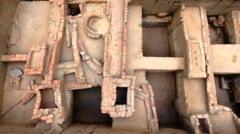The village of Keeladi, located in Tamil Nadu, India, has emerged as a significant archaeological site with discoveries that are reshaping historical narratives and provoking political discourse. Recent excavations, which include 15ft (4.5m) deep trenches, have uncovered artifacts such as terracotta pot fragments and remnants of ancient brick structures, estimated to be 2,000 to 2,500 years old, with some dating back to around 580 BCE. These findings are challenging existing beliefs regarding early urban civilization on the Indian subcontinent.
The discoveries at Keeladi have turned into a symbol of identity and pride for the state, garnering interest from politicians and historians alike. Experts believe that this urban settlement could provide insights into a civilization previously overshadowed by the more documented histories of northern regions, specifically the Indus Valley Civilization. The site is located 12 km (7 miles) from Madurai, selected in 2013 as part of an archaeological survey, following earlier discoveries of pottery by a local schoolteacher in 1975.
Since excavations began in 2014, over 15,000 artifacts have been uncovered, including burial urns and terracotta pipes, displaying evidence of a sophisticated settlement system. Lead archaeologist Ajay Kumar describes the findings as indicative of a literate society with distinct living and functional areas, contending that it stands as the first pronounced ancient urban site in southern India.
The excitement surrounding Keeladi extends beyond its archaeological significance; it reflects a deeper north-south divide in Indian historical narratives. The conventional story has often framed the north as the cradle of urbanization in ancient India, eclipsing contributions from the south. This narrative is being reconsidered due to the findings at Keeladi, which include inscriptions in Tamil Brahmi script that might predate the previously recognized Ashokan script.
Some experts argue that these Tamil Brahmi inscriptions imply a parallel development of scripts rather than a derivative relationship, suggesting that the cultural heritage of Tamil Nadu might not be secondary to that of northern India. The debate over these interpretations has been further fueled by political tensions; for instance, the transfer of prominent archaeologist Amarnath Ramakrishnan has raised concerns of deliberate censorship of Tamil heritage by the central government, with officials citing the need for scientific rigor in reporting.
Despite the controversies, many see the Keeladi excavations as a pathway to understand not only ancient history but also the interconnectedness of cultures. As educational activities unfold at the Keeladi museum, voices like journalist Sowmiya Ashok emphasize the importance of these findings in recognizing a shared history among Indian communities, arguing that the present divisions are often misunderstood reflections of our past rather than clear historical separations.























